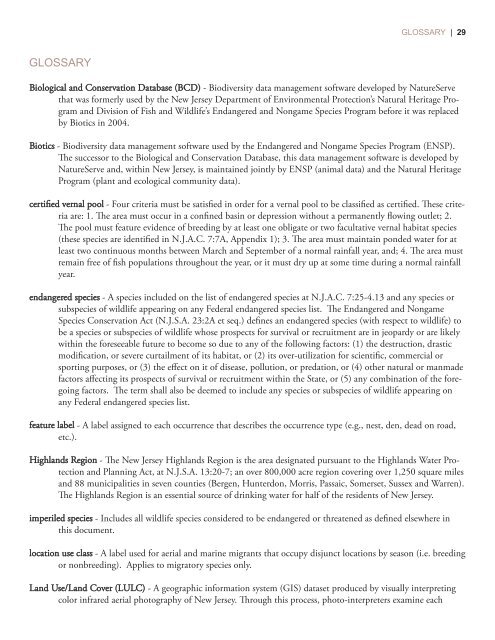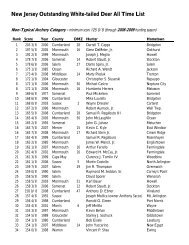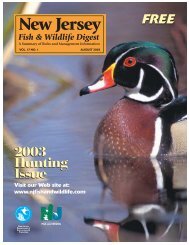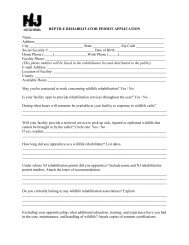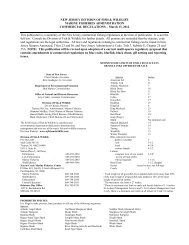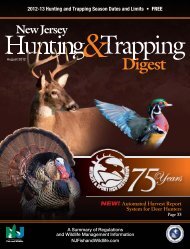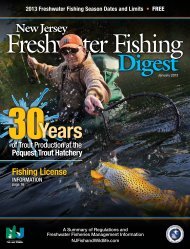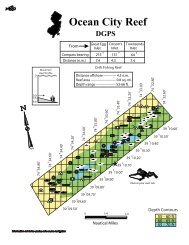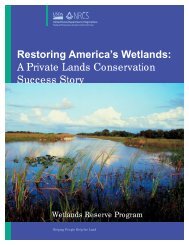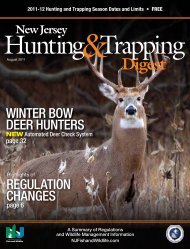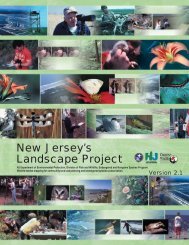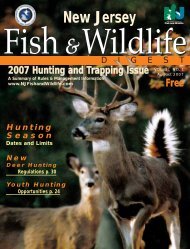Landscape Project Version 3.1 - State of New Jersey
Landscape Project Version 3.1 - State of New Jersey
Landscape Project Version 3.1 - State of New Jersey
You also want an ePaper? Increase the reach of your titles
YUMPU automatically turns print PDFs into web optimized ePapers that Google loves.
GLOSSARY | 29GLOSSARYBiological and Conservation Database (BCD) - Biodiversity data management s<strong>of</strong>tware developed by NatureServethat was formerly used by the <strong>New</strong> <strong>Jersey</strong> Department <strong>of</strong> Environmental Protection’s Natural Heritage Programand Division <strong>of</strong> Fish and Wildlife’s Endangered and Nongame Species Program before it was replacedby Biotics in 2004.Biotics - Biodiversity data management s<strong>of</strong>tware used by the Endangered and Nongame Species Program (ENSP).e successor to the Biological and Conservation Database, this data management s<strong>of</strong>tware is developed byNatureServe and, within <strong>New</strong> <strong>Jersey</strong>, is maintained jointly by ENSP (animal data) and the Natural HeritageProgram (plant and ecological community data).certified vernal pool - Four criteria must be satisfied in order for a vernal pool to be classified as certified. ese criteriaare: 1. e area must occur in a confined basin or depression without a permanently flowing outlet; 2.e pool must feature evidence <strong>of</strong> breeding by at least one obligate or two facultative vernal habitat species(these species are identified in N.J.A.C. 7:7A, Appendix 1); 3. e area must maintain ponded water for atleast two continuous months between March and September <strong>of</strong> a normal rainfall year, and; 4. e area mustremain free <strong>of</strong> fish populations throughout the year, or it must dry up at some time during a normal rainfallyear.endangered species - A species included on the list <strong>of</strong> endangered species at N.J.A.C. 7:25-4.13 and any species orsubspecies <strong>of</strong> wildlife appearing on any Federal endangered species list. e Endangered and NongameSpecies Conservation Act (N.J.S.A. 23:2A et seq.) defines an endangered species (with respect to wildlife) tobe a species or subspecies <strong>of</strong> wildlife whose prospects for survival or recruitment are in jeopardy or are likelywithin the foreseeable future to become so due to any <strong>of</strong> the following factors: (1) the destruction, drasticmodification, or severe curtailment <strong>of</strong> its habitat, or (2) its over-utilization for scientific, commercial orsporting purposes, or (3) the effect on it <strong>of</strong> disease, pollution, or predation, or (4) other natural or manmadefactors affecting its prospects <strong>of</strong> survival or recruitment within the <strong>State</strong>, or (5) any combination <strong>of</strong> the foregoingfactors. e term shall also be deemed to include any species or subspecies <strong>of</strong> wildlife appearing onany Federal endangered species list.feature label - A label assigned to each occurrence that describes the occurrence type (e.g., nest, den, dead on road,etc.).Highlands Region - e <strong>New</strong> <strong>Jersey</strong> Highlands Region is the area designated pursuant to the Highlands Water Protectionand Planning Act, at N.J.S.A. 13:20-7; an over 800,000 acre region covering over 1,250 square milesand 88 municipalities in seven counties (Bergen, Hunterdon, Morris, Passaic, Somerset, Sussex and Warren).e Highlands Region is an essential source <strong>of</strong> drinking water for half <strong>of</strong> the residents <strong>of</strong> <strong>New</strong> <strong>Jersey</strong>.imperiled species - Includes all wildlife species considered to be endangered or threatened as defined elsewhere inthis document.location use class - A label used for aerial and marine migrants that occupy disjunct locations by season (i.e. breedingor nonbreeding). Applies to migratory species only.Land Use/Land Cover (LULC) - A geographic information system (GIS) dataset produced by visually interpretingcolor infrared aerial photography <strong>of</strong> <strong>New</strong> <strong>Jersey</strong>. rough this process, photo-interpreters examine each


